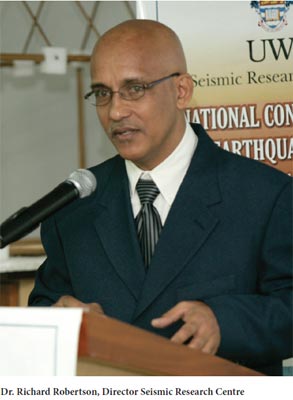

 The location and geologic setting of Trinidad and Tobago make it susceptible to earthquakes. Most of the previous earthquakes which could have caused significant damage have been centered in a number of zones offshore. The location and geologic setting of Trinidad and Tobago make it susceptible to earthquakes. Most of the previous earthquakes which could have caused significant damage have been centered in a number of zones offshore.
Increased vulnerability and our understanding of the seismo-tectonics of the south-eastern Caribbean indicate that the earthquake threat is very significant within the 21st century. (The UWI recently collaborated with the European Centre for Training and Research in Earthquake Engineering (EUCENTRE) to produce new seismic hazard maps for the Eastern Caribbean.)
As the country increases its building stock, population and infrastructure will become exposed to the seismic risk. Implementing mitigation measures and reducing vulnerability are the most effective mechanisms to reduce the potentially devastating impact of future strong and major earthquakes. Measures such as the application of building codes and land use policies are most effective when applied at the planning and design stages of projects. In order to reduce the potential impact of the next large magnitude earthquake that could affect Trinidad and Tobago a comprehensive strategy needs to be determined.
The UWI Seismic Research Centre and the Office of Disaster Preparedness and Management (ODPM) held a two-day national consultation, “Earthquake Safety in Trinidad and Tobago – A call for action!” in early July to identify measures to improve earthquake safety.
Out of just over a dozen presentations on related themes–some identifying vulnerable areas as south-west of Tobago, Toco and Chaguaramas, and that the Central Plain Fault may be locked and could experience a significant magnitude earthquake–discussions identified several deficiencies in the country’s state of preparedness and proposed ways to address them.
Deficiencies identified
At the organisational and administrative level, flaws were found in the design approval process regarding construction of buildings, as well as in the regulation and monitoring of construction.
Since builders and contractors are not licensed, no mechanisms exist to ascertain their competencies or knowledge in earthquake risk reduction techniques.
The registration process for engineers needs improvement.
Data collection on risk assessment and management is inconsistent. No database on building structures exists.
National disaster legislation does not exist, and there is no active public education programme.
Recommendations
Discussions took place at regular intervals between presentations and at the end, several recommendations were made by participants and a way forward proposed. The following outlines those proposals.
- A National Earthquake Stakeholder Organization (NESO) should be set up with a Steering Committee to take the work forward. The NESO should be a public-private partnership to which any individual or organisation can belong.
- The Government should be apprised of recommendations made with respect to Earthquake Risk Reduction.
- A series of workshops/meetings will undertake to establish work groups and define a work programme, designate an operational base, and develop a business plan.
- Specific actions identified by Consultation participants:
a. Short-term (1-2 years)
- Publish a National Building Code and enact legislation to govern its use
- Make the Small Building Code freely available to all builders (one presenter, Richard Clarke, provided a link for builders that he called a free, how-to-manual at http://ideascaribbean.com/hurri/)
- Organise earthquake risk reduction training for engineers, disaster management professions, building inspectors and builders.
- Assess the state of critical facilities with respect to susceptibility to earthquake and determine the needs for retrofitting.
- Undertake economic impact analysis of earthquake risk reduction and analyze the financial requirements for preventative action.
- Analyze the organisational capacity of regulatory and monitoring agencies to undertake the tasks required.
- Develop risk management financial solutions for property owners (driven by the insurance sector).
- Employ engineers with experience in Earthquake Resistant Design in the Regional Corporations and City Councils.
- Establish clear guidelines for the construction of buildings in Trinidad and Tobago.
b. Medium-term (3-5 years)
- Draft and enact national disaster legislation.
- Access the quality of all building stock and determine the needs and costs for retrofitting.
- Undertake comprehensive rehabilitation of critical facilities and infrastructure and implement other required solutions for total national resilience to optimal levels.
- Undertake public awareness programmes designed to obtain a mindset/culture change with respect to natural hazard mitigation.
- Establish a budget for preventative action.
- Undertake scientific quantitative regional loss estimation.
- Review the existing system for the registration of Engineers (including Structural Engineers).
- Review and improve the approval process for building design and construction.
- Establish a mechanism for the licensing of Contractors.
- Instrument the Central Plain Fault.
- Promote and undertake engineering research on unique forms of local construction.
- Establish clear procedures for the registration of foreign engineers working in Trinidad and Tobago.
- Arrange for ongoing training and professional development of staff of the regulatory approval agencies.
|





